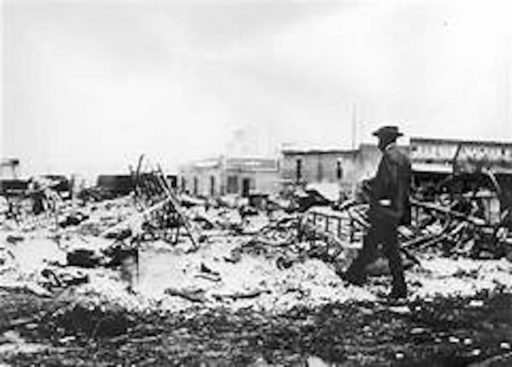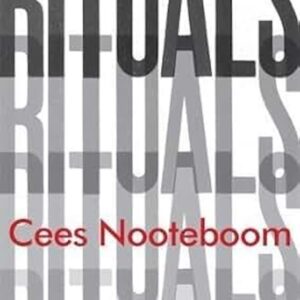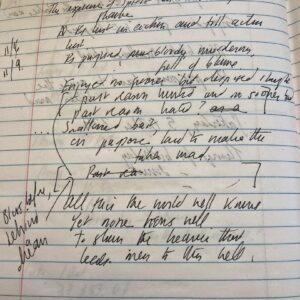May 31 – June 1, 2021 marks the 100th anniversary of the Tulsa Race Massacre.
If you’ve been anywhere near the media in recent weeks, you’ve likely seen the archival photographs, indistinct and muddy, depicting the broken and blasted-out blocks that were all that was left of the city’s affluent Greenwood district—the “Black Wall Street”—after the mob was done with it. A mob that, as the reports tell us, included the Tulsa police force and the National Guard.
The images, framed in the middle distance, mostly do not illustrate the violent events, save for the occasional, indistinct cypher of a lone body—one irreplaceable soul—sprawled upon the pavement.
But they are perhaps more haunting for the destruction that they do not depict, for the erasure that sterilizes memory and elides history. I grew up in OK in the 1980s. Tulsa massacre wasn’t even taught in state history, commented a Twitter user named “theScientificX-over” on a post about the anniversary. I only learned about it when I studied 20th century American history in college on the East coast.
As it happens, I know a little bit myself about the erasure of buried violence.
In fact, in the span of writing this very essay, it took me less than thirty seconds and minimal keystrokes to find this story about my hometown, from June 9, 1907: “NEGROES KILLED IN RIOT; Three Shot to Death Near Yazoo City — Four Whites Wounded.” I had never before heard of this event.
It was on the front page of The New York Times.
The notion that this massacre—in an era when there was plenty of common violence—was on the front of The New York Times, a national newspaper, in an era when the state barely even had paved roads, was unimaginable to me. But at the same time, it was like finding the key to a cryptological alphabet.
The record of my own heritage has become an opportunity for historical excavation.
It’s not a new posture for me: to grow up (for anyone to grow up, really) is the occasion for awareness of the need for repentance—for all kinds of things, not just racial oppression.
But even my awareness of these wrongs has been slow in dawning. There are too many examples even to mention: The swallowed silences about how it was better not to “open up old wounds” that time there was a Movie of the Week about the murders of Schwerner, Cheney, and Goodman (Attack on Terror: The FBI Vs. the Ku Klux Klan, CBS, 1975). Turn that thing off.
The realization that the “good old days” our parents talked about, when people “didn’t have to lock their doors,” were largely because the small town where we lived was effectively a police state. The Confederate battle flags that were not a token of heritage at all, but the product of an anti-desegregation marketing campaign in the 1950s.
The time I was at a party where jazz great Lionel Hampton sat at a piano playing “Dixie” while drunk convention delegates teetered on the dance floor of a Dave and Buster’s, singing—and now all I can wonder about is what Lionel Hampton himself must have been thinking. The whole evening seems like a pantomime to me now. Hampton was eighty-four years old, I read now, which makes it seem an even greater outrage.
I’m neither an activist nor even very political. The great acts of cultural recovery for African-Americans that are taking place in Greenwood and elsewhere right now are vital. But the task that’s most urgent for me personally, and the one for which I’m responsible, is to try to understand what it is that made white folks, with such spectacular blindness, behave this way in the first place. And, in turn, to make acts of reparation.
I’m not racist to nobody, a person says to me. How am I responsible for all the stuff that happened before I was born?
But ah, but if you are a Christian don’t you remember the verse, that the sins of the Fathers are visited upon the sons to the third and fourth generation?
It’s sin, of course. but so much of white sin on race is also mixed with the poison of sentimentality, the kitschy tears that came to the eyes of all the delegates (and sadly, mine too) singing along to Lionel Hampton. It’s that hot-cold mixture of self-deception that seems to have had strangely little exploration in literature.
Fortunately, there’s a master novel that deals with this very subject, which also happens to be about the Greenwood Massacre: Rilla Askew’s Fire in Beulah. Althea Whiteside, the novel’s white female protagonist, is the high-strung, childless wife of an affluent, though blunt and tyrannical, Tulsa oil man.
Cooped up in her elegant house, Althea develops a strange fixation on Graceful, the Black teenage girl she has hired to keep house for her—even as she is effectively blind to Graceful’s independent existence:
She’d never thought about the girl’s life, or her family, where she’d come from. Never dreamed there was anything more to the girl’s existence than her slow, placid movements and the vague stirrings of unease she produced in Althea.
Against the plot’s backdrop of the local unrest that begins to simmer, Althea yaws back and forth between performative acts to emphasize her authority as the lady of the house, ordering the young woman around, and her ongoing attraction to Graceful as a source of mystery and wisdom. Whether bullying or venerating, Althea cannot see Graceful as something other than her own projection—a being with agency, complete and whole.
There’s a lot more about history and place and memory in this novel. If you’ve read Askew’s The Mercy Seat, you’ll recognize again the tangle of rural poverty and Biblical narrative swirling around the lives of whites, Blacks, and Indigenous people—who all share more than separates them but cannot admit it.
But it’s that strange fulcrum, a misguided love mixed with contempt, that immediately seemed so familiar to me, and which I’d never quite seen in a novel before—and certainly not one that focused on the world of women. It’s the pivot point that sets the novel’s violence into motion, but not just this novel only: I fear I will be exploring its implications for the rest of my days.
Caroline Langston was a regular contributor to Image’s Good Letters blog, and is writing a memoir about the U.S. cultural divide. She has contributed to Sojourners’ God’s Politics blog, and aired several commentaries on NPR’s All Things Considered, in addition to writing book reviews for Image, Books and Culture, and other outlets. She is a native of Yazoo City, Mississippi, and a convert to the Eastern Orthodox Church. She lives outside Washington, D.C., with her husband and two children.





